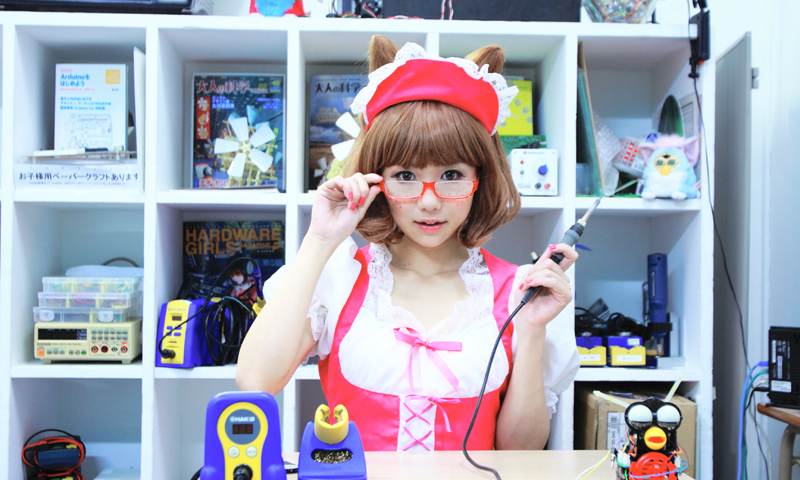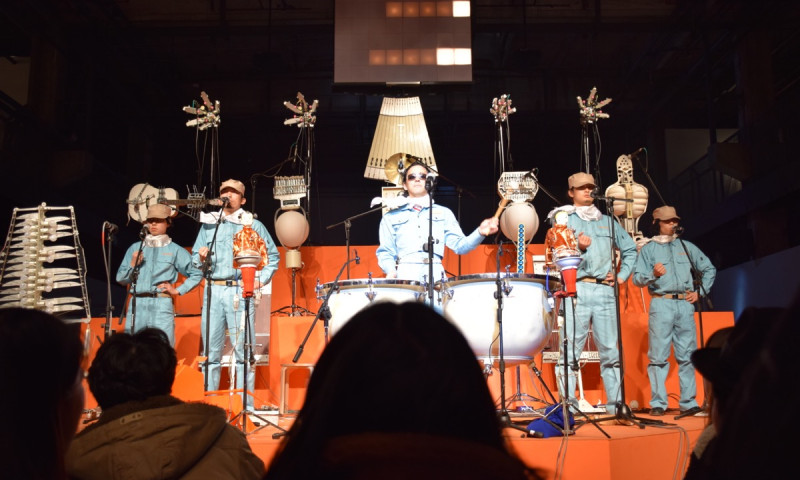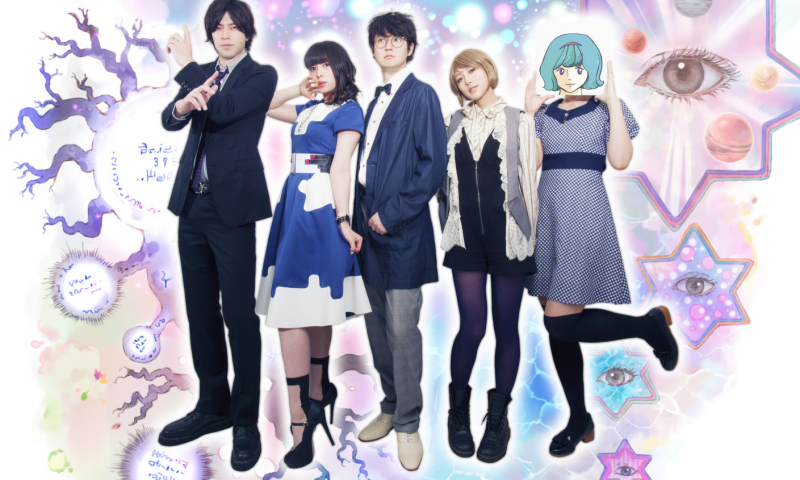
TOKYO CUTTING EDGE CREATORS by Julie Watai #11 featuring Frenesi: The Singer-Songwriting-Animator
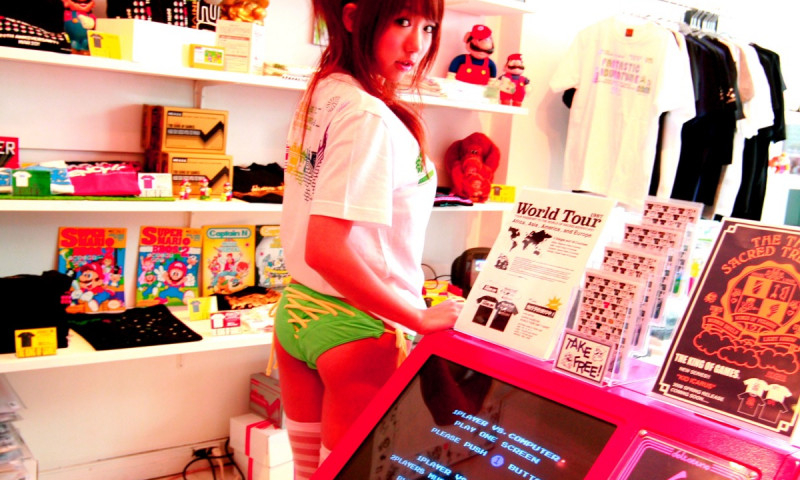
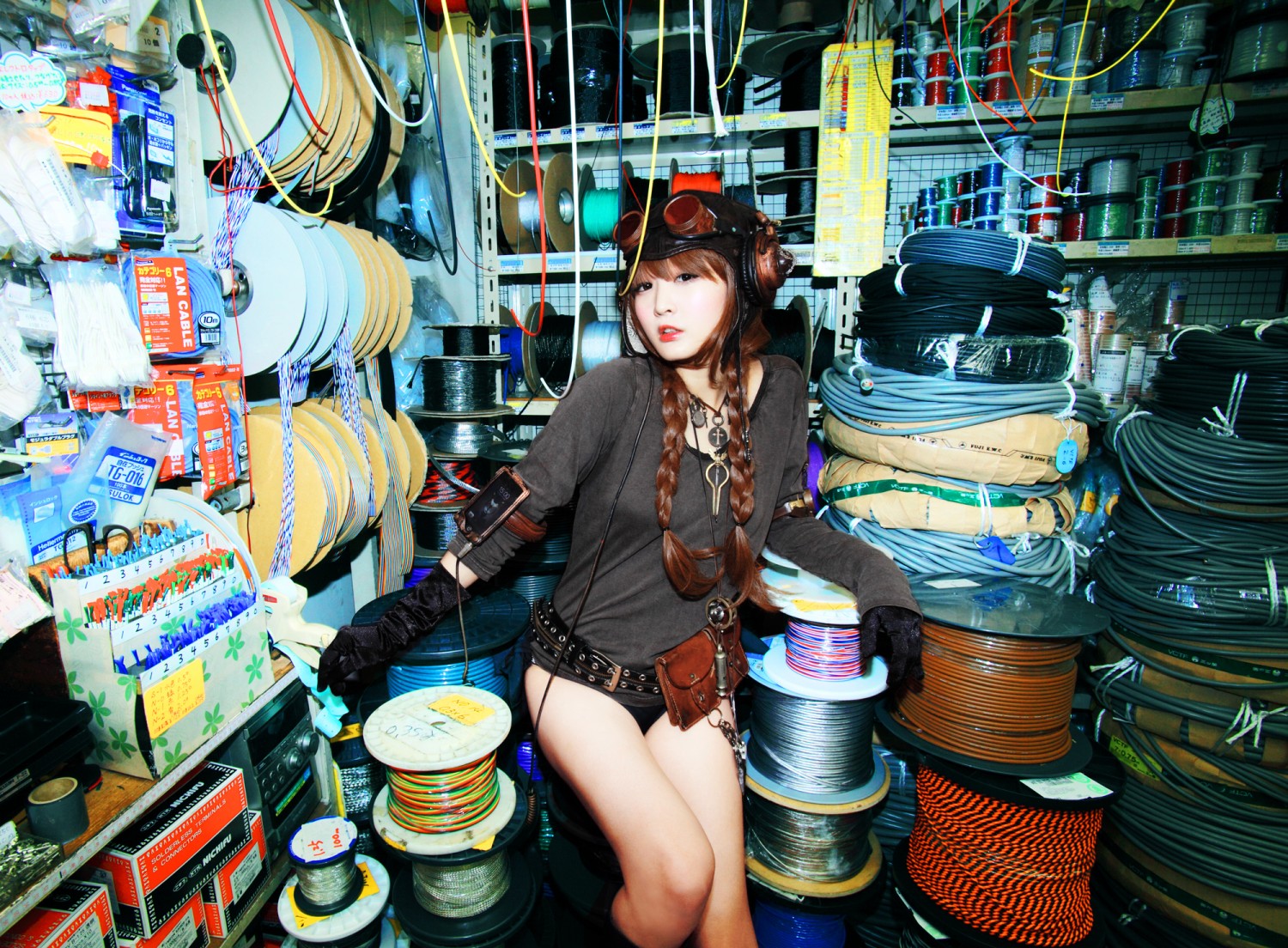
Sponsored Links
After working at an idol in Japan, Julie Watai moved by herself to Italy, publishing SAMURAI GIRL in 2006 while working as a photographer for Italian publishing company DRAGO&ARTS. She quickly became an international Japanese pop culture figure, gaining a large following. After returning to Japan, she continued her work as a photographer, along with developing electronics as a hobby and iPhone apps, and has been remarkably successful as part of the Akiba-style geek culture, too. Then on February 5, 2016, Julie Watai released a photo collection completely shot, styled, and directed herself, with her as the sole subject, called Tokyo Future Classic (DU BOOKS).
日本でアイドルとして活動した後、24歳で単身イタリアに渡り、イタリアの出版「DRAGO&ARTS」からフォトグラファーとして「SAMURAI GIRL」を2006年に出版。日本のポップカルチャーの姿をいち早く世界に発信し、注目を浴びたJulie Watai。帰国後も、フォトグラファーとして作品作りを続ける傍ら、電子工作やiPhoneアプリの開発に携わるなど、アキバ的なギーク文化での活躍も目覚ましい。そして2016年2月5日には、撮影、被写体、スタイリング、ディレクション、すべてを自分でこなした作品を集めた写真集『トーキョー・フューチャー・クラシック』(DU BOOKS)をリリースした。
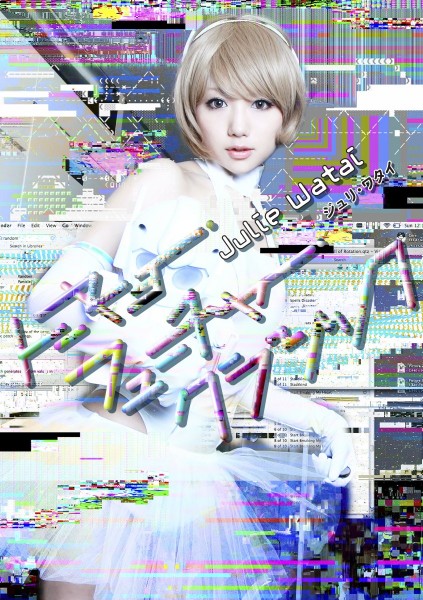
Starting today, we’ll begin publishing Julie Watai’s column, TOKYO CRAZY CREATORS by Julie Watai, on Tokyo Girls’ Update (around the middle of each month), which covers Tokyo’s latest cutting-edge culture! In this series she’ll be interviewing creators that have caught her interest, in order to discover the latest cutting-edge culture in Tokyo. For our first installment, we’ll be interviewing artist Ai☆Madonna, who gained fame for her collaboration goods with idol group Dempagumi.inc among other works. Now she’s a popular creator among young women, but originally she began her career as a painter, creating live paintings of beautiful girls on the streets of Akihabara. Today we’ll be sitting down with her to ask her about her untold story behind her street work, and how Akihabara has changed between then (around 2006-2008) and now, along with the serialization of her first manga. We hope you enjoy their discussion about Ai☆Madonna’s true intentions and Akihabara culture, that only creator Julie Watai can bring you!
そんな東京の最先端カルチャーを常に追いかけ続けてきたJulie Wataiさんの連載『TOKYO CUTTING-EDGE CREATORS by Julie Watai』が、Tokyo Girls’ Updateにてスタート!(毎月中旬頃更新予定)Julie Wataiが注目するクリエイターとの対談を通じ、新たな東京の最先端カルチャーを発見して行く連載です。第1回目の対談相手は、でんぱ組.incとのコラボグッズなどでも有名な芸術家、愛☆まどんなさん。今でこそ若い女の子に大人気のクリエイターさんですが、元々は秋葉原の路上で、美少女の絵をライブペインティングから彼女の活動はスタートしたという。ストリートでの活動や、当時(2006-2008年頃)から現在へ秋葉原カルチャーの変化、また初めての漫画制作についての秘話も伺った。クリエイターJulie Wataiだからこそ引き出せる愛☆まどんなの本音、秋葉原カルチャーについてのディスカッションなどをご堪能あれ!
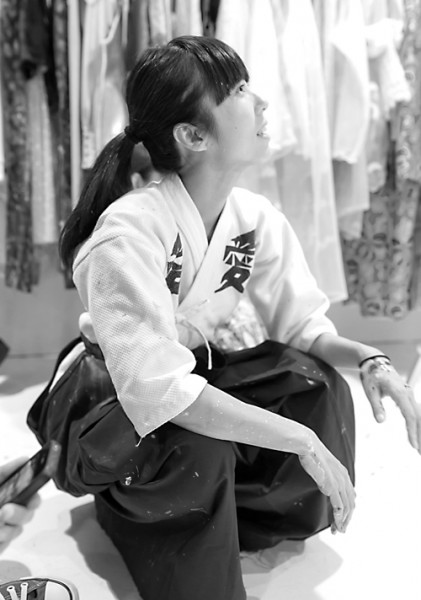
Ai☆Madonna/愛☆まどんな
Julie: It’s been awhile! Thank you for letting me interview you today.
お久しぶりです! 本日はどうぞよろしくお願いします
Ai☆Madonna: Thank you for asking me to be your guest today.
こちらこそ、どうぞよろしくお願い致します。
Julie: Your street paintings and performances still have a vivid impression in my mind, but when did you first start? I remember seeing them published in an art magazine called Bijutsu Techo, and thinking, “Wow, look how pretty these girls are!” I was really shocked at how amazing they were.
愛☆まどんなちゃんというと秋葉原でのストリートペイントやパフォーマンスが鮮烈な印象として残っているんだけど、最初にした時期っていつ頃だったの?私の記憶ではその事が美術手帖という雑誌に掲載されているのを見て、こんなかわいい女性が! すごいなあ、と衝撃を受けましたよ!
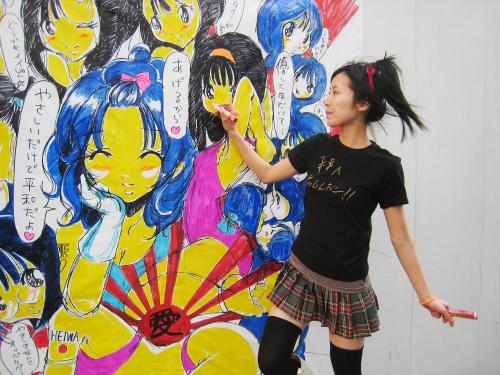
Live painting by Ai☆Madonna in 2008 /2008年、愛☆まどんなさんによるライブペインティング
Ai☆Madonna: I did live painting for a little less than a year, between 2007 and 2008.
ライブペインティングは2007~2008年の一年間弱です。
Julie: I see; that was pretty early considering that Akihabara’s cultural diversity was beginning to spread. That was before the ban, when it was still Pedestrian’s Paradise (a place closed off to vehicle traffic so that people could enjoy eating, drinking, and socializing as they watched street performers and musicians).
なるほど、秋葉原カルチャーの多様性が出てきた時期としてはかなり早いですね。当時は、一旦禁止をされる前の歩行者天国もあったよね。
Ai☆Madonna: That’s right, but even then performances were banned there. Nobody was willing to permit it, it seems.
そうですね、でもホコ天でもパフォーマンスは禁止でした。どこも許可はしてなかったみたいですね。
Julie: Ah, that’s right, the performances were banned. But there were still a lot of performers appearing back then…
あ、そうだパフォーマンス禁止だった。でもあの時期はいろいろなパフォーマーが出ていましたが……。
Ai☆Madonna: Now Pedestrian’s Paradise has returned, but I imagine the atmosphere in Akihabara has changed quite a bit?
今はホコ天も復活しましたが、秋葉原の雰囲気もだいぶかわったかな?
Julie: There are many more tourists now.
観光客が多くなったよね。
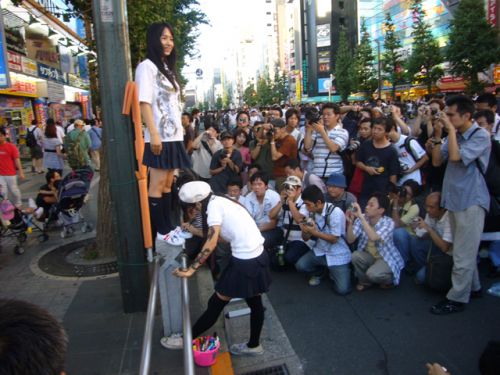
Street Live painting at Akihabara by Ai☆Madonna, in 2008 /2008年、愛☆まどんなさんによる秋葉原ストリートライブペインティング
Ai☆Madonna: Before (around 2007-2008), the place was full of street idols!
あの時期(2007-2008年頃)、路上アイドルいっぱいいました!
Julie: Street idols! Did anyone particularly stand out?
路上アイドル! 有名どころだと誰かいた?
Ai☆Madonna: There were idols that picked up litter or wore thongs as they flashed people.
ゴミ拾いアイドルとか、Tバックでパンチラ見せまくるアイドルとか。
Julie: Oh… Those kind of idols, huh? (laugh) It seems like those kind of street performances became somewhat of a social problem.
うおお…そっち方面か(笑)。こういった分野のパフォーマンスが社会問題にもなっていたような。
Ai☆Madonna: I think it was around the same time that Akihabara Dear Stage opened up.
秋葉原ディアステージもちょうどこの頃オープンしたよね。
Julie: It’d been there for quite some time. Speaking of Dear Stage, Mofuku, the owner, started building and incorporating a wave of new culture into Akihabara, didn’t she?
そんな前からあったんですね。ディアステと言えば、もふく社長もかなり前から、秋葉原で新しいカルチャーの流れを意識的に取り入れて育ててきた方だよね。
Ai☆Madonna: AKB48 began their activities around then, too.
AKB48が始まったのもこの頃かも。
Julie: Because the Akihabara culture movement back then was so quick, even things that happened only a little before seem like they happened such a long time ago. What made you want to start performing on the streets in Akihabara, back when it wasn’t in the public eye?
ここ何年かの秋葉原はカルチャーの動きが早すぎるから、少し前の出来事ももう遠い昔みたいに感じるよね。当時まだまだ一般的には注目を浴びていなかった秋葉原という土地でストリートペイントパフォーマンスをしようと思ったきっかけはあったのかな?
Ai☆Madonna: My work there was at the insistence of a person named Ichiro Endo. He believed that the style of my work would be readily received there, and since news often traveled quickly there, that it would soon become a hot topic. To be honest, I’d never visited Akihabara before then. I had no idea what kind of place it was.
アキバでの活動は遠藤一郎くんという方が背中を押してくれたのがきっかけでした。作風的にアキバで受けそうだし、情報拡散力の早いアキバからならすぐ話題になる!って思ったそうです。実際私自身はアキバにそれまで一度も行ったことなかったし。アキバがどんな街かもよく知らなかったです。
Julie: You mean Ichiro Endo, the future artists? (she asks as she does a quick search for him)
遠藤一郎さんって未来美術家の方?(パソコンで検索しながら)
http://www.goforfuture.com
Ai☆Madonna: That’s right! He was also published in BT (Bijitsu Techo) at the time.
そうそう! あの時の号のBT(美術手帖)にも載ってます。
Julie: I see, he was also an artist, too. I’m fond of contemporary art, but because my tastes are a little biased, I’m just now hearing about him for the first time. So at Mr. Endo’s advice, you started doing live paintings in Akihabara. Did draw any attention at first?
なるほど、この方自身もアーティストなんですね。私も現代美術は好きなんだけれども、好みが偏っているので、遠藤さんの事は今知りました。そこで遠藤さんからのアドバイスを受け、アキバでライブペイントを始めたんですね。最初はどんな反響があったの?
Ai☆Madonna: Par for the course, I received quite a lot of criticism.
当たり前ですが、批判もかなり多かったですよ。
Julie: Like criticism from Akihabara fundamentalists?
批判って、アキバ原理主義者の方からとか、かな?
Ai☆Madonna: Because Akihabara is also a corporate town, there were complaints from people who worked in the offices there, and I received daily threats from people who liked to complain. Things like, “You should stop because your art is terrible!”
秋葉原は会社街でもあるので、オフィスの人から苦情くるし、通報魔と名乗る人から毎回通報されたり。絵下手なくせにやめろ!みたいな。
Julie: Really?! That must have been really hard. There’s a fine line between street art utilizing your body and danger.
えええ! 相当大変な思いをされましたね、それは。体当たりのストリートアートと危険って、紙一重でもあるんですね。
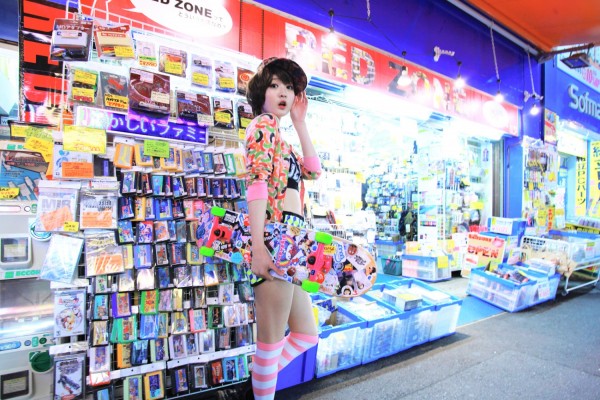
Street photo at Akihabara by Julie (model : Yurika Kubo, 2013) /Julieによる秋葉原ストリートフォト(モデル:久保ユリカ 2013年)
Ai☆Madonna: There were definitely pros and cons to it! I couldn’t help but stand out.
賛否両論ですよね! 目立つことすると仕方ないです。
Julie: That’s true. Yet you still continued to go out and work on the streets. How many times did you go?
そうだね。そんな状況の中、何度もストリートの活動はやってるよね。何回くらいしました?
Ai☆Madonna: I went every Sunday for about a year.
一年間くらい、毎週日曜日にやってました
Julie: Every week! That’s quite often. So it means there were something more than you expected?
毎週! そりゃ結構な頻度でやっていたんですね。そこでの手応えがあったということ?
Ai☆Madonna: I looked forward to people’s reactions, and enjoyed it much like it was a club activity. With each time there were more and more people who would come and watch, and there was a DVJ (a unit fusing music by a DJ and videos by a VJ together) working with me, along with girls dressed up and having a good time in cosplay. As the number of participants increased, I began making goods and selling them, which made for a pretty good amount of pocket money so I’d treat everyone that helped out to McDonald’s. (laugh)
手応えというか、サークル活動みたくて、自分が楽しかったんですね。 回を重ねるたびに目当てにみに来てくれる人も増えたし、一緒に活動してくれるDVJ(DJによる音楽とVJによる映像の融合ユニット)とか、コスプレして盛り上げてくれる女の子とかがいたり。メンバーも増えて、グッズとかもこの頃から作って売ったりしてて、けっこういいお小遣いになるので、手伝ってくれるみんなにもマックおごれたし(笑)。
Julie: That’s right, having a DVJ with you made for an amazingly impactful, audio and visual live painting experience, and it was really cool. It was the kind of composite art you don’t see much of in Japan, let alone the closed-off atmosphere that Akihabara had! (laugh) Did you also sell your goods on the street?
そうそう、DVJの方と一緒に、聴覚的、視覚的にもインパクトのすごいライブペイントもされていて、かっこよかったです。あれは日本のストリートではなかなか見られない総合芸術だったのではと思います! しかもまだ若干閉鎖的な雰囲気も残っていた秋葉原で!笑 グッズもストリートで販売していたの?
Ai☆Madonna: There aren’t many large-scale performances like that on the street, are there. (laugh) Using a single car I’d paint the outside while the DVJ played while leaning over the sunroof, and we’d sell our goods from the car and then jump inside and run away whenever the police came. (laugh)
ストリートではここまで大掛かりなパフォーマンスは普通やらないですよね(笑)。車一台を稼働して、車体に絵を描いて、サンルーフからDVJが身を乗り出してプレイして、車内で物販して、警察来たらそのまま車走らせて逃げてました(笑)。
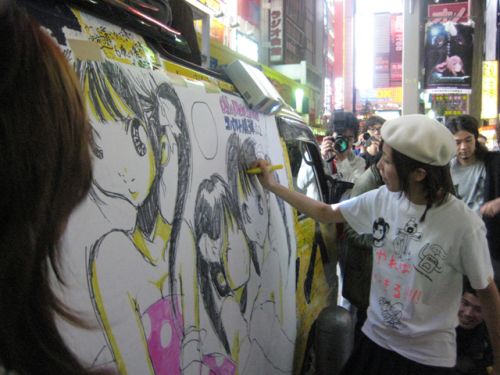
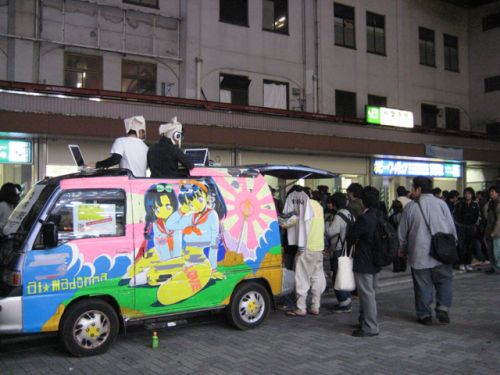
Street painting at Akihabara in 2008
Julie: It was a totally new experience at the time! That’s just too cool. Although it’d been better if you hadn’t been caught. (laugh) Listening to the artists that currently define the Akiba, it sounds like they had already realized its ideal form. Nevertheless, treating people to McDonald’s like that, it sounds like it was great- like it was like a real club. At they time there weren’t many places to eat around Akihabara at the time, right? So McDonald’s was really valuable. Now that you mention it, I also caught the attention of the police around the same time while performing on the streets. (laugh)
当時としては斬新すぎる試み! かっこよすぎます。しかし捕まらなくてよかったね(笑)。今のアキバ系を体現するアーティストの子達からすると、理想系をすでに実現されていたんだなーと思います。それにしても、マックおごるとか、本当サークル活動みたいでいいね。当時秋葉原には飲食店少なかったしな。だから、マックは貴重だったね。そういえば同時期頃に私も音楽でストリートライブやって、警察に注意受けました(笑)。
Ai☆Madonna: That’s right! I’d heard about you!
ですよね! ジュリちゃんのことも私は知っていました!
Julie: It was really scary! What was I thinking back then? (laugh)
恐縮すぎるんですが! 私、当時何やってたんだろう(笑)
Ai☆Madonna: I thought you were some gravure idol!
グラビアアイドルかと思ってました!
Julie: Oh, I did that kind of work under a different name. Let’s just leave it at that, though. (laugh)
あ、それ別名義でやってたやつですね。その話はこの場ではそっとしておいてください(笑)。
Ai☆Madonna: It makes me think of a perfectly cute girl leaping away from the two-dimensional.
二次元から飛び出したような完璧にかわいい女の子、という印象!
Julie: (sweatdrop)
汗
Julie: You’re very famous in the current fashion and idol world, as well as the pop art world, but in particular, what lit the fire of your popularity in the fashion world?
そして現在ファッションやアイドル、もちろんポップアートの世界でも大人気の愛☆まどんなちゃんですが、特にファッション分野で人気に火がついたきっかけとかあるのかな?
Ai☆Madonna: I think having my illustrations used in fashion is what made more people come to know my name. Then I went from fashion to idol (costume and goods illustrations), more and more younger people learned of me, and then I think high school girls in particular started spreading my name.
多くの方に知ってもらえたきっかけは、ファッションでイラストを使ってもらえたことかなと思います。ファッション→アイドル(の衣装やグッズのイラスト)を通して、若い世代の人に知ってもらえて、特に女子中高生がたくさん「愛☆まどんな」を拡散してくれたんじゃないかなと思います。
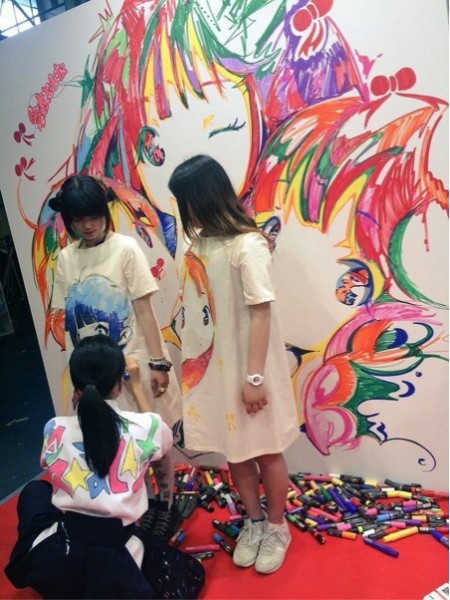
Live paiting on the white dresses at Japan Expo 2015/2015年、パリのジャパンエキスポにてパフォーマンスした際、女の子をナンパして、その場でワンピースに絵を描いた
Julie: You had a hand in creating a number of idol goods, and then younger girls started wearing illustrations of your comic touch style drawn girls. I often see pictures on SNS of idols or internet idols wearing t-shirts with your illustrations on them. I’ve caught your items lining an incredible amount of shelves, like Village Vanguard. Is there any item that’s especially popular?
アイドルグッズなども多数手掛けられるようになってから、ファッションとして若い女性が愛☆まどんなちゃんの描くコミックタッチの女の子イラストを身にまとうようになって。イラスト入りTシャツとかアイドルやネットアイドル女の子達が着てる写真をSNSでもよく見かけます。ビレバン(ヴィレッジヴァンガード)とかでも物凄い陳列棚を多々目撃してすごいなって。中でも特に人気のグッズとかありますか?
Ai☆Madonna: Yes, I’m really indebted to them, and it’s changed quite a bit since the beginning. I’d have to say the “Kusatte mo Lolicon!” t-shirt.
そうですね、ビレバンにお世話になりはじめてから、大分変わったかな。人気は「くさってもロリコン!」Tシャツかな!
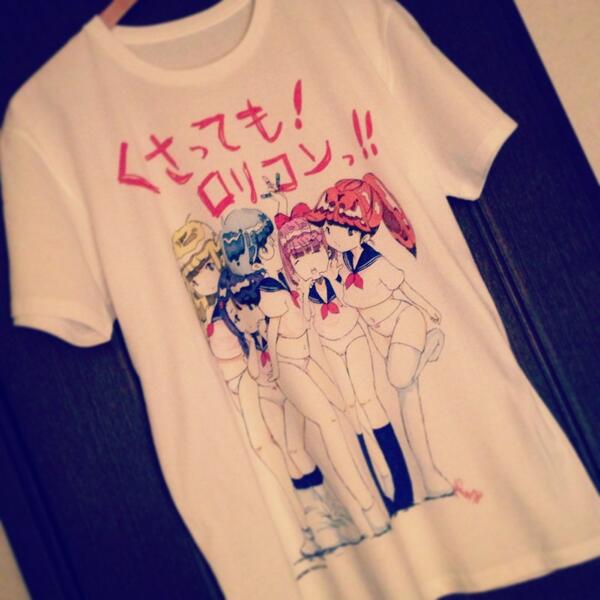
Julie: Oh! That’s one of your quotes!
ああ!出た名言!
Ai☆Madonna: It might just be the masterpiece of my goods.
これはあいまグッズのマスターピースかも。
Julie: I think you really cleared the way for all the illustrated t-shirts you see stylish subculture girls wearing now. Catchphrases like “Kusatte mo Lolicon!” are pretty funny. Do you come up with them yourself?
今のサブカルおしゃれ女子たちが着てるイラストTとか、全て愛☆まどんなちゃんがこの流れの道筋を作ってきたんだと思います。「くさってもロリコン!」みたいなキャッチコピーも面白いよね。自分で考えてるの?
Ai☆Madonna: I do.
そうそう。
Julie: Are they linked with your illustrations in any way?
そういったキャッチコピー、もしやイラストと連動していたりする?
Ai☆Madonna: They are. I can’t come up with anything without drawing first.
はい、イラスト描いてからでないと思い浮かばないです。
Julie: I see! That’s interesting. So your illustrations come first.
なるほど!面白いですね。イラストが先にあるんだ。
Ai☆Madonna: Or rather, it’s like I can hear what the girl in the illustration is saying. I just spoke like a real artist, didn’t I!
思い浮かぶってゆうか、絵の中の女の子が言ってるのが聞こえる気がします。今、美術家っぽいこと言ったぞ!
Julie: So you hear things like. “Kusatte mo Lolicon!” (laugh) Your choice of words seems to have really stuck with younger women, too. They’re sharp, but charming. Compared to when you first started out and now, otaku mixed pop art has really gained momentum. How do you feel about that?
くさってもロリコン! と聞こえるんだ(笑) 。その言葉選びのセンスもまた若い女性に刺さるんですよね、きっと。尖ってるけどチャーミングで。愛☆まどんなちゃんが活動をはじめた当初に比べ、今やオタクミックスのポップアート分野に勢いが出ていますよね。正直今の流れってどう思いますか?
Ai☆Madonna: The “girls drawing girls themed art style” has really grown a lot. Even yuri (girls’ love) styles are now the norm!
めちゃくちゃ増えましたよね、「女の子が女の子をモチーフに絵を描くスタイル」。百合っぽさももはや当たり前ですね!
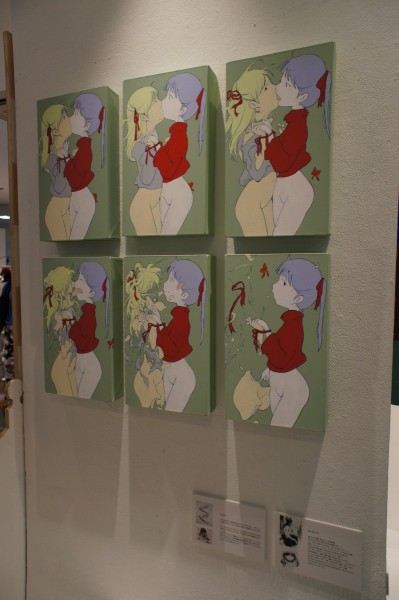
Ai☆Madonna’s latest paintings on canvas (acrylic paint, 2016) /愛☆まどんなさん一番最近の連作のキャンバス絵(2016製作/キャンバス、アクリル)
Julie: Right! And now so-called two-dimensional girl-like characters have become characteristic of the trend.
そうそう。そしてトレンドはちょっといわゆる「二次元美少女」っぽいキャラクターなのも特徴。
Ai☆Madonna: I think there are two different types of cute, “cute without realizing it” and “trendy cute”. Those that are part of the current trend are in the latter group, always looking around at other girls as if they’ve got an antenna on their heads, and I look on, wondering if this trend is just part of a fad like with fashion.
かわいいって思う気持ちには2種類あって、「無性にかわいい」と「流行ってるからかわいい」があると思うんです。今の流れは後者で、女の子はいつも周りをよく見ていて、流行りのアンテナがビンンビンなので、この流れもファッションみたく流行りの一部なのかなって思って見張ってます。
Julie: I see. It certainly seems like that when you think of it as girls’ fashion tastes.
なるほど、女子のファッションの感性からすると確かにそうだね。
Ai☆Madonna: I don’t go to events anymore like Design Festa or Geisai, but now they feature an increasing amount of fancy moe-style accessories. As long as the girl making it is cute, it’ll sell.
デザフェスとか、ゲイサイとか、今全然行ってないのでわからないですが、今そのようなイベントでは萌えファンシー系?の手作り雑貨すごい増えているらしいですね。作ってる子がかわいいと、それだけで売れるから。
Julie: Yeah, even on online handmade goods sites they’re recruiting people.
ああ、オンラインでも手作りサイトに人が集まってるみたいだよね。
Ai☆Madonna: I think there’s an idol kind of element to it.
この世界にも、アイドル要素はありますよね。
Julie: There are creators that appear as an icon. There are girls that are really good at selling themselves like that.
作り手自らもアイコンとして登場してる。そういう見せ方のうまい子もいるね。
Ai☆Madonna: Right? And taking selfies has really become a thing now.
ね、自撮りがめちゃ増えたってのもあるから。
Julie: With SNS and smartphone selfies, for the most part girls now have really perfected being self-produced.
SNSやスマホの自撮りを通して今の女子達は全体的に、セルフプロデュース術の腕が上がりましたね。
Ai☆Madonna: I agree! You can really make yourself look cute with smartphone selfie apps. Even purikura now is awe-inspiring.
そう思う! スマホの自撮りもアプリで可愛くなれるし。今のプリクラも恐ろしいですよね。
Julie: I haven’t taken any purikura recently. Are you talking about the ones that make your eyes bigger?
最近プリクラ撮ってないなあ。目が大きくなるやつとか、かな?
Ai☆Madonna: That kind of alien-looking face is the ones girls prefer now, but it’s a little sad. Big eyes, sharp jawlines, and super long legs…
あの宇宙人みたいな顔を女子達が良しとしてるのが、なにか悲しいんですよ。目が大きくて、顎が鋭く尖って、脚が激長で。
Julie: Oh, that’s not what I had expected. I figured since you draw perfectly cute two-dimensional girls, that you would be one to prefer pretty, deformed three-dimensional girls.
あら、それは意外かも。パーフェクトな二次元美少女を描く愛☆まどんなちゃんは、三次元でもデフォルメされた美少女像がお好みなのかと思ってた。
Julie: Well, do you think that in the future otaku mixed-style art will fade and become yesterday’s trend?
じゃあ、今後オタクミックス系アートは一過性の流行で終焉を迎えると思う?
Ai☆Madonna: I don’t think that it will fade, but people might get tired of it.
終わらないとは思うけど、飽きられる可能性は十分ありますね。
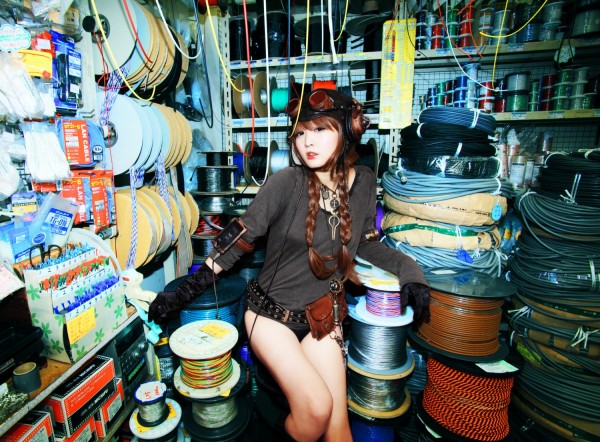
Street photo at Akihabara by Julie Watai (model : Yurika Kubo, 2013) location : Oyaide-Denki) /Julieによる秋葉原ストリートフォト。(モデル:久保ユリカ2013年・ロケーション オヤイデ電気)
Julie: Oh, so you don’t think it’ll disappear completely, but there’s a change it’ll continue as just a fad. Speaking of which, what kind of work have you been doing recently?
うーん、完全には無くならないだろうけども、流行りで盛り上がってる可能性ってやっぱりあるね。そういえば最近はどんな作品を作ってるの?
Next : Ai☆Madonna’s latest work is…surprising!!
愛☆まどんなさんの最新作とは!?
Sponsored Links

Natsume Mito is a Paper Doll in the Paper World MV for “I’ll do my best”!

8th Wave of Tokyo Idol Festival 2016 Performers Announced!!


